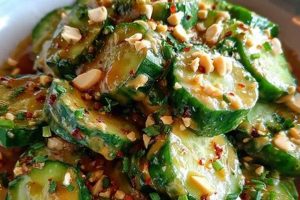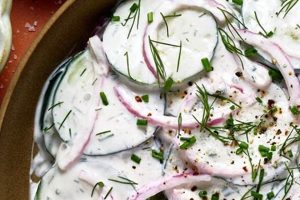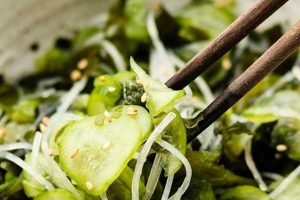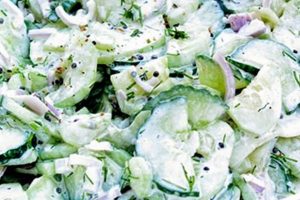Refreshing and versatile, salads combining cucumbers and tomatoes offer a wide range of culinary possibilities. From simple combinations with a light vinaigrette to more complex additions like onions, herbs, or feta cheese, these salads represent a healthy and flavorful option. A classic example includes sliced cucumbers and tomatoes dressed with olive oil, vinegar, salt, and pepper.
These salads provide significant nutritional benefits. Cucumbers are a good source of hydration and contain antioxidants. Tomatoes are rich in vitamins C and K, as well as the antioxidant lycopene. Such dishes are often featured in Mediterranean diets and have been enjoyed across cultures for generations, adapting to regional ingredients and preferences. Their adaptability makes them suitable for picnics, barbecues, or as a light accompaniment to heavier meals.
The following sections explore variations on this classic combination, including diverse ingredients, dressings, and preparation techniques to enhance flavor and presentation. From exploring regional variations to understanding optimal ingredient selection, this exploration aims to provide a comprehensive resource for creating delightful cucumber and tomato salads.
Tips for Cucumber and Tomato Salads
Achieving optimal flavor and texture in a cucumber and tomato salad relies on careful consideration of ingredients and preparation techniques. The following tips offer guidance for creating a truly exceptional dish.
Tip 1: Ingredient Selection Opt for ripe, flavorful tomatoes. Consider heirloom varieties for enhanced taste and visual appeal. Choose firm cucumbers with smooth skin.
Tip 2: Salting Cucumbers Salting cucumbers before adding them to the salad draws out excess moisture, preventing a watery final product. Slice the cucumbers, sprinkle with salt, and let them sit for 15-20 minutes before rinsing and patting dry.
Tip 3: Knife Skills Consistent slicing ensures even flavor distribution and enhances presentation. Aim for uniform sizes when chopping both cucumbers and tomatoes.
Tip 4: Dressing Choices A simple vinaigrette of olive oil, vinegar, salt, and pepper is a classic choice. Experiment with different vinegars, such as red wine vinegar, balsamic vinegar, or lemon juice, to complement the flavors of the vegetables.
Tip 5: Herbaceous Enhancements Fresh herbs can elevate the salad’s flavor profile. Consider adding chopped dill, mint, parsley, or oregano.
Tip 6: Adding Red Onion Thinly sliced red onion adds a pungent bite. Soaking the sliced onions in cold water for 10 minutes can mellow their sharpness.
Tip 7: Timing is Key Dress the salad just before serving to prevent the vegetables from becoming soggy. This preserves their crispness and texture.
By following these guidelines, one can create a cucumber and tomato salad that is both flavorful and visually appealing. Attention to detail, from ingredient selection to proper preparation techniques, ensures a delightful culinary experience.
These fundamental elements contribute to a successful and satisfying cucumber and tomato salad. The subsequent section will delve into specific recipe variations.
1. Fresh, High-Quality Ingredients
The foundation of any successful cucumber and tomato salad rests upon the selection of fresh, high-quality ingredients. Subpar produce will inevitably result in a lackluster dish, regardless of preparation techniques. The quality of ingredients directly impacts the final flavor, texture, and overall enjoyment of the salad.
- Ripe Tomatoes:
Ripe tomatoes offer a sweetness and juiciness essential for balancing the other flavors in the salad. Choosing tomatoes at their peak ripeness ensures optimal flavor and texture. Look for tomatoes with vibrant color, a slight give when gently squeezed, and a fragrant aroma. In-season, locally sourced tomatoes are often the best choice. Examples include heirloom varieties like Brandywine, Cherokee Purple, or San Marzano for a deeper, richer flavor. Underripe or overripe tomatoes can negatively impact the overall quality of the salad.
- Firm Cucumbers:
Cucumbers contribute a refreshing crispness and subtle, vegetal flavor to the salad. Selecting firm cucumbers with smooth, unblemished skin is crucial. Avoid cucumbers that feel soft or have wrinkled skin, as these indicate age and potential bitterness. European cucumbers, known for their thin skin and fewer seeds, are an excellent choice for salads. Proper storage of cucumbers is also important for maintaining their freshness.
- Fragrant Herbs:
Fresh herbs add another layer of complexity and aroma to the salad. Dill, mint, parsley, and oregano are popular choices, each contributing a unique flavor profile. Using fresh herbs rather than dried significantly enhances the overall sensory experience. For example, freshly chopped dill adds a bright, slightly tangy flavor that complements both cucumbers and tomatoes. Ensure the herbs are vibrant in color and free from wilting or browning.
- Extra Virgin Olive Oil:
High-quality extra virgin olive oil provides a healthy fat source and carries the flavors of the other ingredients. A robust olive oil with a peppery or fruity flavor can elevate the salad. Avoid using lower-grade oils, as these can have a negative impact on the overall flavor profile. A small amount of quality olive oil contributes significantly to the salad’s richness and mouthfeel.
The interplay of these fresh, high-quality ingredients forms the core of a delicious cucumber and tomato salad. Prioritizing quality at the ingredient selection stage sets the stage for a truly satisfying culinary experience, showcasing the simple elegance of fresh produce.
2. Balanced Flavor Profiles
Balanced flavor profiles are essential for creating truly enjoyable cucumber and tomato salads. A well-balanced salad avoids extremes in any single flavor, creating a harmonious blend of tastes that complement each other. Achieving this balance requires careful consideration of the ingredients and their inherent characteristics, including acidity, sweetness, saltiness, and bitterness. The interplay of these elements determines the overall sensory experience.
- Acidity:
Acidity provides brightness and cuts through the richness of the other ingredients. Vinegar is a common source of acidity in cucumber and tomato salads. Different types of vinegar, such as red wine vinegar, white wine vinegar, apple cider vinegar, or lemon juice, offer varying levels of acidity and subtle flavor nuances. Too much acidity can make the salad overly tart, while too little can result in a bland dish. The right balance of acidity enhances the flavors of the tomatoes and cucumbers.
- Sweetness:
Sweetness balances the acidity and provides a counterpoint to the savory elements. Ripe tomatoes naturally contribute sweetness to the salad. Adding a touch of sweetness can further enhance the flavor profile. A small amount of sugar or a drizzle of honey can be used judiciously to achieve the desired balance. However, excessive sweetness can overpower the other flavors.
- Saltiness:
Salt enhances the flavors of the other ingredients and provides a savory depth. Salt also helps to draw out moisture from the cucumbers, preventing a watery salad. Proper salting is crucial; too much salt can make the salad unpalatable, while too little can result in a bland dish. Using high-quality sea salt or kosher salt can further enhance the flavor.
- Bitterness (Optional):
A touch of bitterness can add complexity and depth to the salad. Ingredients like red onion or certain herbs can contribute a subtle bitterness. However, bitterness should be used sparingly, as it can easily overpower the other flavors. If incorporating bitter elements, balance them carefully with the other taste components.
By carefully considering and balancing these flavor components, one can create a cucumber and tomato salad that is not only refreshing but also complex and nuanced in its flavor profile. The harmonious interplay of acidity, sweetness, saltiness, and optional bitterness elevates a simple salad to a truly satisfying culinary experience. This balance allows the natural flavors of the cucumbers and tomatoes to shine through, creating a dish that is both flavorful and refreshing.
3. Proper Preparation Techniques
Proper preparation techniques are crucial for maximizing the flavor, texture, and overall quality of cucumber and tomato salads. These techniques ensure that the ingredients retain their freshness and contribute optimally to the final dish. From selecting and handling produce to specific cutting methods and timing considerations, attention to detail in preparation significantly impacts the salad’s success.
- Ingredient Handling:
Proper handling of cucumbers and tomatoes preserves their texture and minimizes moisture loss. Washing produce gently but thoroughly removes surface contaminants. Storing cucumbers separately from tomatoes, and refrigerating both until ready for use, helps maintain their individual qualities. Overhandling can bruise delicate tomatoes, and improper storage can lead to premature spoilage.
- Moisture Control:
Controlling moisture content, particularly in cucumbers, is essential for preventing a watery salad. Salting sliced cucumbers draws out excess moisture through osmosis. This process, followed by rinsing and patting the cucumbers dry, ensures a crisper, more flavorful salad. Failing to address excess moisture can dilute the dressing and compromise the overall texture.
- Cutting Techniques:
Uniform slicing and chopping contribute to both aesthetics and even flavor distribution. Consistently sized pieces ensure that the dressing coats the ingredients evenly and that each bite offers a balanced blend of flavors. Knife skills are essential for achieving clean cuts and preventing the vegetables from being crushed or bruised. For example, slicing tomatoes with a sharp knife prevents excessive juice loss, preserving their texture and flavor.
- Timing and Assembly:
Timing is crucial for maintaining the freshness and crispness of cucumber and tomato salads. Preparing ingredients close to serving time prevents premature softening and wilting. Adding the dressing immediately before serving ensures that the vegetables retain their texture and prevents the salad from becoming soggy. This also allows the flavors of the ingredients to remain distinct and vibrant.
These proper preparation techniques collectively contribute to the creation of a superior cucumber and tomato salad. By emphasizing careful handling, moisture control, precise cutting, and timely assembly, one can maximize the quality and enjoyment of this refreshing and versatile dish. The attention to detail in these seemingly simple steps significantly impacts the final product, demonstrating the crucial connection between proper preparation and culinary success.
4. Creative Ingredient Combinations
Elevating cucumber and tomato salads beyond the basic requires exploring creative ingredient combinations. Strategic additions introduce complexity and depth, transforming a simple dish into a culinary experience. The following facets highlight how specific ingredients interact with the core components, enhancing flavor, texture, and nutritional value.
- Cheese:
Cheese introduces creamy textures and savory notes. Feta, with its salty tang, complements the fresh vegetables. Goat cheese offers a slightly earthier flavor, while crumbled blue cheese adds a pungent dimension. Consider mozzarella for a milder, milky contrast.
- Other Vegetables:
Expanding beyond the base ingredients offers textural and flavor variations. Thinly sliced red onion provides a sharp bite. Avocado adds creaminess and healthy fats. Bell peppers contribute sweetness and crunch. Chopped fresh herbs, such as dill, mint, or parsley, enhance the aromatic profile.
- Grains and Legumes:
Adding grains or legumes transforms the salad into a more substantial meal. Quinoa or couscous introduce nutty flavors and satisfying textures. Chickpeas or lentils provide protein and fiber, enhancing nutritional value. These additions contribute heartiness and complexity.
- Fruits:
Fruits introduce sweetness and contrasting textures. Watermelon or cantaloupe complement the cucumber’s refreshing qualities. Stone fruits, such as peaches or nectarines, add a delicate sweetness and seasonal flair. These additions enhance the salad’s vibrancy and complexity.
Strategic incorporation of these ingredients elevates cucumber and tomato salads from simple to sophisticated. The interplay of flavors and textures creates a dynamic culinary experience, showcasing the versatility of this classic combination. Each addition offers unique contributions, expanding the possibilities and allowing for customization based on individual preferences and dietary needs. Careful balancing of these additions ensures a harmonious and flavorful final product.
5. Visually Appealing Presentation
Visual appeal significantly enhances the dining experience, even for simple dishes like cucumber and tomato salads. Presentation elevates the perceived value and enjoyment of the salad, transforming it from a basic side dish to a more engaging culinary creation. Careful consideration of color, texture, and arrangement transforms ingredients into an aesthetically pleasing composition.
- Color Contrast:
Vibrant color contrasts stimulate visual interest. The deep red of ripe tomatoes against the cool green of cucumbers creates an inherent contrast. Incorporating ingredients with complementary colors, such as yellow bell peppers or orange carrots, further enhances visual appeal. Employing a variety of tomato types, like heirloom varieties with diverse hues, amplifies this effect. Monochromatic presentations, while elegant, may lack the vibrancy achieved through contrasting colors.
- Textural Variation:
Textural variation adds another dimension to visual appeal. The smooth surface of sliced tomatoes juxtaposed with the crisp texture of chopped cucumbers provides visual and tactile interest. Incorporating ingredients with different textures, such as crumbled cheese, toasted nuts, or crunchy croutons, further enhances this element. A salad with uniform textures may appear monotonous, lacking the visual appeal achieved through diverse textural elements.
- Plating Techniques:
Plating techniques significantly influence visual appeal. Arranging ingredients thoughtfully, rather than simply tossing them together, creates a more polished presentation. Consider layering ingredients or arranging them in distinct sections on the plate. Using appropriate serving dishes, such as shallow bowls or platters, enhances visual appeal. A simple garnish, like a sprig of fresh herbs or a drizzle of olive oil, adds a finishing touch. Haphazard plating diminishes the perceived value of the salad, even if the ingredients themselves are high quality.
- Cutting Styles and Shapes:
Varying cutting styles and shapes add visual dynamism. Instead of uniform slices, consider incorporating different cuts, such as diced cucumbers, wedges of tomatoes, or shaved red onion. Using specialized tools, such as a mandoline, allows for precise and consistent cuts, creating a professional appearance. Uniformity in cutting, while efficient, may lack the visual interest achieved through varied shapes and sizes. The interplay of different cuts and shapes contributes to a more engaging visual presentation.
These elements of visual presentation elevate cucumber and tomato salads, enhancing the dining experience. The interplay of color contrast, textural variation, considered plating, and varied cutting styles transforms a simple salad into a visually appealing culinary creation. By focusing on these aspects, one can elevate the perceived value and enjoyment of even the most basic cucumber and tomato salad recipe.
6. Adaptability and Versatility
The adaptability and versatility of cucumber and tomato salad recipes contribute significantly to their enduring popularity. These qualities allow for customization based on individual preferences, dietary needs, seasonal ingredient availability, and cultural influences. This inherent flexibility ensures that the basic combination of cucumbers and tomatoes remains a relevant and appealing culinary option across diverse contexts.
- Dietary Adaptations:
Cucumber and tomato salads easily accommodate various dietary restrictions. Vegan and vegetarian diets readily embrace this naturally plant-based dish. Gluten-free versions require minimal adjustments, focusing on ingredient selection for dressings and add-ins. Low-carbohydrate diets benefit from the low carbohydrate content of the primary ingredients. Adjustments for other dietary needs, such as low-sodium or low-fat, are similarly straightforward, emphasizing ingredient choices and preparation methods.
- Seasonal Variations:
Seasonal variations enhance cucumber and tomato salads by incorporating peak-season produce. Summer versions highlight the abundance of ripe tomatoes and cucumbers. Spring variations might include early greens or herbs. Autumn adaptations incorporate ingredients like roasted squash or pumpkin seeds. Winter versions can utilize preserved or dried tomatoes and cucumbers. This responsiveness to seasonal availability ensures access to optimal flavors throughout the year.
- Cultural Adaptations:
Cucumber and tomato salads manifest differently across various cultures. Mediterranean versions often include feta cheese, olives, and oregano. Middle Eastern variations might incorporate mint, parsley, and lemon juice. Asian-inspired versions may feature sesame oil, rice vinegar, and ginger. These cultural adaptations showcase the fundamental versatility of the dish, highlighting regional flavor preferences and culinary traditions.
- Meal Versatility:
Cucumber and tomato salads function effectively in diverse meal contexts. As a light lunch, they offer a refreshing and nutritious option. As a side dish, they complement grilled meats, fish, or poultry. Incorporated into larger composed salads, they contribute textural and flavor complexity. As a component of appetizers or tapas, they provide a light and flavorful element. This versatility extends their utility across a range of culinary applications.
The adaptability and versatility of cucumber and tomato salads ensure their continued relevance in contemporary cuisine. These qualities allow for seamless integration into diverse dietary preferences, seasonal variations, and cultural contexts. The ability to transform a simple combination of ingredients into a multitude of culinary expressions secures the enduring appeal of cucumber and tomato salad recipes.
Frequently Asked Questions
This section addresses common inquiries regarding cucumber and tomato salad preparation, offering practical solutions and clarifying potential misconceptions.
Question 1: How can one prevent a watery cucumber and tomato salad?
Salting cucumbers prior to adding them to the salad draws out excess moisture. Slice the cucumbers, sprinkle them with salt, and let them sit for approximately 15-20 minutes. Rinse the salt off and pat the cucumber slices dry before combining them with other ingredients. This process prevents the salad from becoming diluted.
Question 2: What are the best tomato varieties for this type of salad?
Ripe, flavorful tomatoes are essential. Heirloom varieties, such as Brandywine, Cherokee Purple, or San Marzano, offer rich flavor profiles. In-season, locally sourced tomatoes generally provide the best flavor and texture.
Question 3: Can cucumber and tomato salads be prepared in advance?
While the ingredients can be prepared separately in advance, it is recommended to combine and dress the salad just before serving. This preserves the crispness of the vegetables and prevents the salad from becoming soggy.
Question 4: How can one enhance the flavor of a basic cucumber and tomato salad?
Fresh herbs, such as dill, mint, parsley, or oregano, significantly enhance flavor. A simple vinaigrette, using high-quality olive oil and vinegar, also elevates the taste. Other additions, like crumbled feta cheese or thinly sliced red onion, introduce complexity.
Question 5: What are suitable pairings for cucumber and tomato salads?
These salads complement a variety of dishes. They serve as a refreshing side to grilled meats, fish, or poultry. They also pair well with Mediterranean or Middle Eastern cuisine.
Question 6: How should cucumbers and tomatoes be stored for optimal freshness?
Store cucumbers and tomatoes separately in the refrigerator. Cucumbers benefit from being wrapped in a slightly damp paper towel and placed in a plastic bag. Tomatoes should be stored stem-side down at room temperature for optimal flavor, then refrigerated if not used within a day or two.
Understanding these key aspects of preparation and ingredient selection ensures a successful and enjoyable cucumber and tomato salad experience.
This concludes the frequently asked questions section. The following section offers a selection of specific recipe variations.
Cucumber Tomato Salad Recipes
Exploration of cucumber tomato salad recipes reveals a dish adaptable to diverse culinary preferences and nutritional needs. From ingredient selection and preparation techniques to creative flavor combinations and presentation, attention to detail elevates this seemingly simple salad. Optimal ingredient quality, balanced flavor profiles, proper handling of produce, and creative additions transform basic components into a satisfying culinary experience. The versatility of cucumber tomato salad recipes extends from light lunches to elegant side dishes, adapting readily to various dietary restrictions and cultural influences.
The enduring appeal of cucumber tomato salad recipes lies in their simplicity, adaptability, and capacity for culinary refinement. Continued exploration of flavor combinations, presentation techniques, and cultural variations promises further evolution of this classic dish, ensuring its continued presence in culinary traditions worldwide. Careful consideration of these elements allows one to fully appreciate the potential of cucumber tomato salad recipes, transforming readily available ingredients into a delightful culinary expression.






